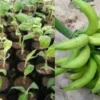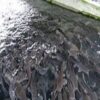- このトピックは空です。
- 投稿者投稿
- 3月 25, 2025 2:11 am #604800
The success of any aquaculture venture relying on earthen ponds hinges significantly on meticulous site selection and soil properties.
A well-chosen location, coupled with suitable soil characteristics, ensures water retention, pond stability, and ultimately, optimal fish production.
This article delves into the critical factors to consider when selecting a site and assessing soil for earthen pond construction, laying the groundwork for a thriving aquaculture operation.
1. Topography And Water Availability
The topography of the potential site plays a crucial role in pond construction and water management. Gently sloping land is preferred as it minimizes earthwork and facilitates efficient drainage. Adequate water availability is paramount.
The site should have access to a reliable water source, such as a river, stream, or groundwater, capable of replenishing water lost through seepage and evaporation. The elevation of the site relative to the water source is also important, allowing for gravity-fed water supply whenever possible. Furthermore, the presence of natural depressions or valleys can be advantageous, reducing the need for extensive excavation.
2. Soil Texture And Permeability
Soil texture, defined by the proportions of sand, silt, and clay, directly impacts water retention. Clayey soils are highly desirable due to their low permeability, minimizing water loss through seepage.
Conversely, sandy soils exhibit high permeability, making them unsuitable for earthen ponds unless lined with impermeable materials. Soil permeability should be thoroughly assessed through field tests and laboratory analysis.
The presence of excessive gravel or rocks can also hinder pond construction and increase seepage. A uniform soil texture across the pond area is preferred for consistent water retention.
3. Soil Chemistry And Nutrient Content
Soil chemistry influences water quality and nutrient availability in the pond. Soil pH should be within a suitable range for the intended aquaculture species. Highly acidic or alkaline soils may require amendments to achieve optimal conditions.
Nutrient content, particularly nitrogen and phosphorus, affects pond productivity. Soils with moderate nutrient levels are generally preferred, as excessive nutrients can lead to algal blooms and water quality deterioration. Soil salinity is also a crucial factor, especially in coastal areas, as high salinity can limit the growth of many freshwater aquaculture species.
4. Environmental Considerations And Regulations
Environmental considerations are paramount in site selection. The site should be free from pollutants and contaminants that could harm aquatic life. Proximity to industrial areas, agricultural fields with excessive pesticide use, or waste disposal sites should be avoided. Compliance with local environmental regulations is essential.
Permits may be required for pond construction and water extraction. The potential impact of the pond on surrounding ecosystems, such as wetlands or riparian zones, should be carefully evaluated. Sustainable aquaculture practices should be prioritized to minimize environmental footprint.
5. Accessibility And Infrastructure
Accessibility to the pond site is crucial for construction, maintenance, and harvesting. The site should be accessible by roads or other means of transportation. Proximity to markets and processing facilities is also important for efficient distribution of aquaculture products.
The availability of electricity and other infrastructure, such as drainage systems, should be considered. Adequate infrastructure reduces operational costs and facilitates efficient pond management.
Optimal site selection and soil properties are the cornerstones of a successful earthen pond-based aquaculture operation. By carefully considering topography, water availability, soil texture, chemistry, environmental factors, and infrastructure, aquaculturists can create ponds that are productive, sustainable, and profitable.
Read Also: Research-Extension-Farmer Linkage: Understanding Its Importance and Functionality
- 投稿者投稿
- このトピックに返信するにはログインが必要です。





